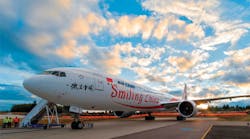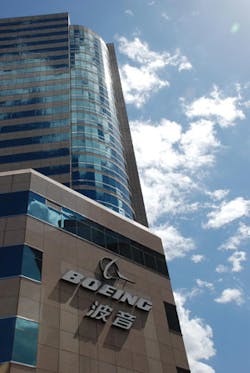Growing GDPs.
Growing middle classes.
Growing demand.
In the not-so-distant future, North America and Europe will take a back seat to another emerging power in the aerospace world.
A region that is aggressively seeking to capitalize on the growth potential in the industry. A region in which governments are establishing clear national strategies for aerospace development. A region full of fledgling companies eager to harness the winds of change and propel themselves into the limelight.
The Asia-Pacific region is, by all accounts, ready to soar.
In the next 20 years, the region is set to at the very least double the numbers of aircraft in its fleet. Likewise, air passenger traffic growth is posed to annually increase at above-average rates of about 6%.
As the middle class in the region grows and establishes the financial wherewithal to fly, air traffic demand will skyrocket, says Paul Nef, business development director of Asia-Pacific for Honeywell Aerospace.
Thus, the world's largest airplane manufacturers and suppliers are looking beyond their native borders and established markets to cash in on the next long-term growth opportunity.
See Also: Lean Manufacturing Leadership Best Practices
Seattle-based Boeing (IW 500/14) and France-based Airbus (IW 1000/52) both are betting heavily on the Asia-Pacific region.
"The Asia-Pacific market is where the action will be in the air over the next 20 years," says John Leahy, COO of Customers for Airbus.
"Growing economies, bigger cities and increasing wealth will see more people flying."
But it's already happening. Today, about one-third of the orders Airbus currently has on the books are for the Asia-Pacific region.
When coupled with the number of existing aircraft in the skies, Asia-Pacific represents 31% of its total portfolio.
"It's going to be an exciting future," says Marc Allen, vice president of Boeing International and president of Boeing China.
Partnering for the Future
Boeing predicts the number of aircraft in Asia-Pacific will nearly triple, with the region supporting as many as 14,750 airplanes, while Airbus anticipates a doubling of aircraft to 10,440 jets. (Where Boeing sees a need for more smaller single-aisle jets, Airbus expects demand for larger twin-aisle aircraft.)
Yet, to remain cost-effective, even as they increase the number of aircraft in the skies, airplane manufacturers are looking for ways to do so more efficiently to reduce the environmental impact that such an influx of traffic will have on the area.
"Airlines are having to find ways to deliver more capacity year over year than most airlines in the world have to deal with," Allen says.
To bring further fuel-saving, energy-conserving concepts to reality, companies are turning to a mainstay in the aerospace industry: partnerships.
"It's necessary, it's strategically necessary, for our success," Allen says. "We're committed to that strategy and it's one we pursue aggressively."
In partnership with the Commercial Aircraft Corp. of China (COMAC), a six-year-old state-controlled Chinese aircraft manufacturer, Boeing in August 2012 launched the Boeing-COMAC Aviation Energy
Conservation and Emissions Reductions Technology Center, a collaboration designed to develop innovations like aviation biofuel.
The idea is to partner with regional manufacturers to create a foundation for future technological advancements and at the same time develop relationships with those companies.
Boeing certainly isn't alone in that strategy.
GE Aviation and the Aviation Industry Corp. (AVIC) in 2011 developed a 50/50 joint venture, AVIAGE, to develop open architecture avionics systems.
"GE Aviation is a long-term strategic partner with China's aviation aspirations," says Rich Kennedy, manager o
f media relations for GE Aviation. "The market, of course, is enormous, but GE also collaborates very well with the Chinese aviation community from a technology standpoint."
At Honeywell, developing those relationships with the players in the regional market is critical.
That's why the company strives not only to work with the big aerospace names like Boeing, Airbus, Embraer (IW 1000/654) and Bombardier (IW 1000/281), but also establishes early relationships with those companies just breaking into the market.
"It's only a matter of time, in my opinion, [before] COMAC moves up to a position where it can compete with Boeing and Airbus," Nef says.
Honeywell thus has made its way onto COMAC's debut aircraft -- the C919, a narrow-body airliner set to make its first flight next year.
Taking a Tech Step Forward
With this aggressive growth comes the opportunity to make significant advances in technology, to come out of the gate on the forefront of next-generation aviation systems.
For example, Honeywell's SmartPath Precision Landing System uses GPS satellite data and transmits guidance signals digitally. Systems such as these replace the older Instrument Landing Systems, which can be at risk for signal interference.
As new airports, new runways and new aerospace infrastructures are developed, there's a decision to be made: incorporate the standardized systems established nearly half a century ago or take a leading role in adopting the newer technologies that are shaping the future of aviation.
"They can, in a sense, leapfrog the existing infrastructure of North America and Europe," Nef says.
"I don't see Asia-Pacific necessarily driving them, but there is certainly opportunity for Asia-Pacific to lead or get somewhat ahead of them."
Yet, convincing relatively new players in the global aerospace market to adopt newer technologies in favor of the standardized systems is a bit of an uphill climb, Nef admits.
"They see standardized systems and want one, too," he says.
However, in North America, the existing infrastructure already is being gradually upgraded to the next generation air traffic management system. And, in Europe, through the Single European Sky initiative, efforts are being made to increase airspace efficiency.
Safety First
The hesitance in the Asia-Pacific region to adopt cutting-edge technologies reflects the safety concerns that dominate the industry, an industry driven by safety and heavily regulated.
"The aerospace industry in general is highly susceptible to the public perceptions of danger," Nef says.
Despite being the safest mode of travel, any in-flight issues with airliners weigh heavily on the public conscience, a reality that daily reinforces the commitment to safety before either innovation or cost.
As a huge influx of new aircraft take to the skies, maintaining that reputation for safety will be of paramount importance to ensure successful growth.
China, in particular, has for decades held itself to universal safety standards, even as it first developed its own commercial aviation market, a resolve that now bodes well for the region.
|
To learn more about aerospace expansion in the Asia-Pacific region, visit iw.com/next-frontier.
|
"Today, it has a safety record that is as good as anybody's around the world. It's at the top," Allen says. "That's a huge enabler for the system. I think it's a huge differentiator. That, too, gives us a strong level of confidence in the growth."







